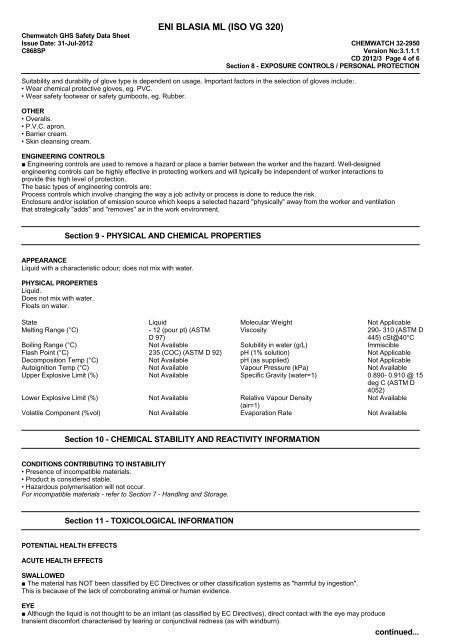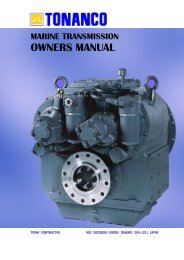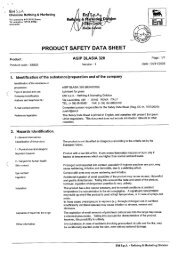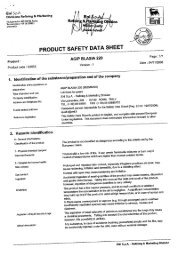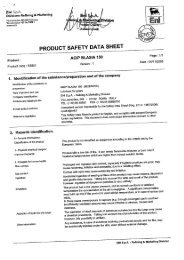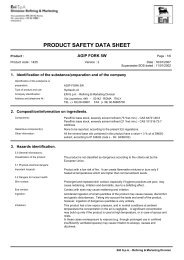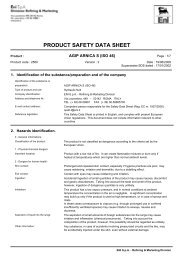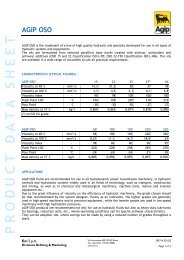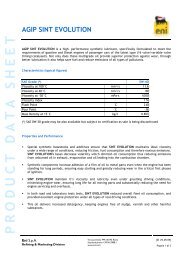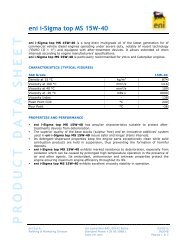eni blasia ml (iso vg 320) ghs sds 32-2950 - TransDiesel
eni blasia ml (iso vg 320) ghs sds 32-2950 - TransDiesel
eni blasia ml (iso vg 320) ghs sds 32-2950 - TransDiesel
You also want an ePaper? Increase the reach of your titles
YUMPU automatically turns print PDFs into web optimized ePapers that Google loves.
ENI BLASIA ML (ISO VG <strong><strong>32</strong>0</strong>)<br />
Chemwatch GHS Safety Data Sheet<br />
Issue Date: 31-Jul-2012 CHEMWATCH <strong>32</strong>-<strong>2950</strong><br />
C868SP<br />
Version No:3.1.1.1<br />
CD 2012/3 Page 4 of 6<br />
Section 8 - EXPOSURE CONTROLS / PERSONAL PROTECTION<br />
Suitability and durability of glove type is dependent on usage. Important factors in the selection of gloves include:.<br />
• Wear chemical protective gloves, eg. PVC.<br />
• Wear safety footwear or safety gumboots, eg. Rubber.<br />
OTHER<br />
• Overalls.<br />
• P.V.C. apron.<br />
• Barrier cream.<br />
• Skin cleansing cream.<br />
ENGINEERING CONTROLS<br />
■ Engineering controls are used to remove a hazard or place a barrier between the worker and the hazard. Well-designed<br />
engineering controls can be highly effective in protecting workers and will typically be independent of worker interactions to<br />
provide this high level of protection.<br />
The basic types of engineering controls are:<br />
Process controls which involve changing the way a job activity or process is done to reduce the risk.<br />
Enclosure and/or <strong>iso</strong>lation of emission source which keeps a selected hazard "physically" away from the worker and ventilation<br />
that strategically "adds" and "removes" air in the work environment.<br />
Section 9 - PHYSICAL AND CHEMICAL PROPERTIES<br />
APPEARANCE<br />
Liquid with a characteristic odour; does not mix with water.<br />
PHYSICAL PROPERTIES<br />
Liquid.<br />
Does not mix with water.<br />
Floats on water.<br />
State Liquid Molecular Weight Not Applicable<br />
Melting Range (°C) - 12 (pour pt) (ASTM Viscosity 290- 310 (ASTM D<br />
D 97)<br />
445) cSt@40°C<br />
Boiling Range (°C) Not Available Solubility in water (g/L) Immiscible<br />
Flash Point (°C) 235 (COC) (ASTM D 92) pH (1% solution) Not Applicable<br />
Decomposition Temp (°C) Not Available pH (as supplied) Not Applicable<br />
Autoignition Temp (°C) Not Available Vapour Pressure (kPa) Not Available<br />
Upper Explosive Limit (%) Not Available Specific Gravity (water=1) 0.890- 0.910 @ 15<br />
deg C (ASTM D<br />
4052)<br />
Lower Explosive Limit (%) Not Available Relative Vapour Density Not Available<br />
(air=1)<br />
Volatile Component (%vol) Not Available Evaporation Rate Not Available<br />
Section 10 - CHEMICAL STABILITY AND REACTIVITY INFORMATION<br />
CONDITIONS CONTRIBUTING TO INSTABILITY<br />
• Presence of incompatible materials.<br />
• Product is considered stable.<br />
• Hazardous polymerisation will not occur.<br />
For incompatible materials - refer to Section 7 - Handling and Storage.<br />
Section 11 - TOXICOLOGICAL INFORMATION<br />
POTENTIAL HEALTH EFFECTS<br />
ACUTE HEALTH EFFECTS<br />
SWALLOWED<br />
■ The material has NOT been classified by EC Directives or other classification systems as "harmful by ingestion".<br />
This is because of the lack of corroborating animal or human evidence.<br />
EYE<br />
■ Although the liquid is not thought to be an irritant (as classified by EC Directives), direct contact with the eye may produce<br />
transient discomfort characterised by tearing or conjunctival redness (as with windburn).<br />
continued...


